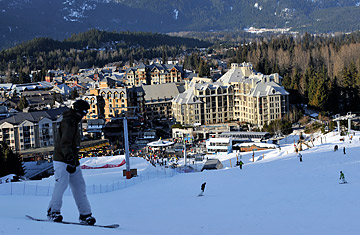
Skiers and snowboarders run down to Whistler Village ski resort.
Wet rainy weather blotted out the men's Olympic downhill event Saturday, but Olympians weren't the only ones not skiing. The slopes of Whistler and Blackcomb Mountains, which comprise the Games' alpine racing area, were relatively deserted. With only about 10% of the mountains being used for downhill races, that left the vast majority of these two mountains wide open in peak season, with no wait at the lifts, when normally they'd be choked with skiers.
On a normal weekend day Whistler draws about 20,000 skiers. Barely 10,000 made it up the slopes the weekend before the Games began. It's an oddity known in the business as "Olympic aversion." Two million people are scheduled to descend on the Vancouver area to watch the Olympic Games over the next two weeks, but although the competition is staged at one of the world's great ski areas, very few visitors will actually ski. "The snow is spectacular. The town is Olympic ready, Games ready. The energy is off the charts," says Bill Jensen, CEO of Intrawest, the company that owns the resort.
But little of that energy will be expended on the mountain. Visitor traffic was down so much the weekend before the Games that Whistler had to advertise the fact that it was open. Part of the reason for the drop in attendance was that the ski resort "lost control of the parking lots on February 1," Jensen explains (they were ceded to the Olympics), so day skiers weren't making the trip.
Weather has also been one of the big stories here. Cypress Mountain, which hosts the half-pipe and mogul skiing events, is so barren of snow the white stuff had to be trucked in from the colder reaches of the Great White North. At Whistler, it's been raining at the bottom of the mountain, which washed away the schedules for the men's downhill and the women's super combined events. In Olympic events, you ski to the bottom of the hill, and the bottom was slushy.
But at the top of the mountain, where all the rank amateurs ski, conditions have been great. Some 35 feet of snow have fallen on Whistler through January. On Saturday morning, it was wet on the bottom but snowing hard at the summit, which at about 7,000 ft. is a mile higher than the base. Our guide told us not to worry. Whistler must have about 10 different weather systems on any given day, it seems. "We're going to drop a couple of hundred feet out of this cloud and it will clear up," he said. For 30 seconds we skied blindly, but then the clouds suddenly parted, and we were in an area called Symphony bowl that was full of new snow, and all but empty of skiers.
The lack of skiers was not unexpected. Whistler, in fact, didn't even volunteer to host the Games — the resort doesn't really need the exposure. But once Vancouver won the Games, Whistler essentially had to rent itself out to the Vancouver Organizing Committee (VANOC) to provide the slopes for the men's and women's alpine skiing events, including the downhill, slalom, giant slalom, super G and the super combined. The contract calls for VANOC to reimburse Whistler for skier days lost to the Games. "VANOC's done a good job," says Jensen. "They're making us whole."
For locals and for visitors who happen to bring their skis and boots along "Olympic aversion" is a boon. In peak season, the locals would normally have to share the place with the skiing hordes. Now they have the joint to themselves while the bars, restaurants and hotels that provide many of them with employment are hopping. "The people who live in Whistler are skiing their brains out," says Jensen. Once it stops raining at the bottom, the Olympic ski racers will join them.
